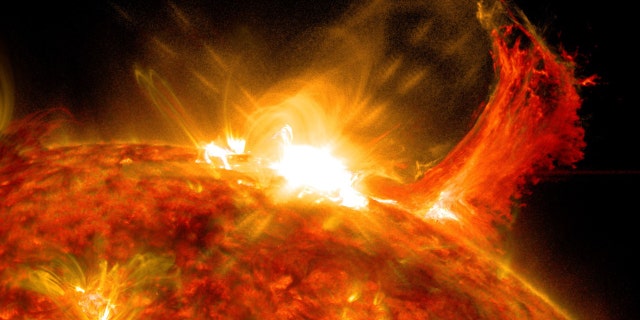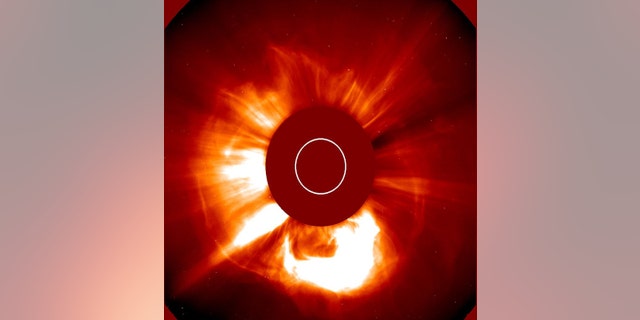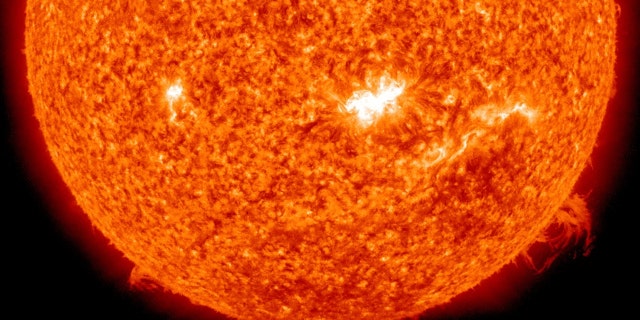NASA said Thursday that a new computer model that combines artificial intelligence and agency satellite data could help prepare for dangerous space weather.
The model, called DAGGER (Deep Learning Geomagnetic Perturbation), uses the technical tool to analyze spacecraft measurements of the solar wind and forecast where an impending solar storm will strike on Earth – with 30 minutes of advance warning.
An international team of researchers at the Frontier Development Lab said the model can produce predictions in less than a second, with predictions updating every minute.
The lab is a partnership that includes NASA, the U.S. Geological Survey and the Department of Energy.
WEBB TELESCOPE CAPTURES WARPED SPACE, GALAXIES BILLIONS OF LIGHT-YEARS AWAY

NASA’s Solar Dynamics Observatory captured this image of a solar flare on Oct. 2, 2014. The solar flare is the bright flash of light at top. A burst of solar material erupting out into space can be seen just to the right of it. (Credits: NASA/SDO)
The scientists had used A.I. to look for links between the solar wind and geomagnetic interruptions, applying a method called “deep learning” that trains computers to recognize patterns based on previous examples.
The model was tested against previous geomagnetic storms from August 2011 and March 2015, with DAGGER accurately forecasting the storm’s impacts. Previously, models had used A.I. to forecast for specific locations, but NASA said DAGGER is the first to combine A.I. with real measurements to generate frequent and precise predictions worldwide.
“With this AI, it is now possible to make rapid and accurate global predictions and inform decisions in the event of a solar storm, thereby minimizing – or even preventing – devastation to modern society,” Vishal Upendran of the Inter-University Center for Astronomy and Astrophysics in India, who is the lead author of a paper about the DAGGER model published in the journal Space Weather, said in a statement.

In this handout from the Solar & Heliospheric Observatory, a major solar eruption is shown in progress Oct. 28, 2003. (Solar & Heliospheric Observatory/NASA via Getty Images)
NEIL DEGRASSE TYSON SAYS JAMES WEBB SPACE TELESCOPE IS WINDOW TO UNIVERSE ‘NEVER BEFORE ACHIEVED’
He noted that the computer code in the DAGGER model is open source, and could be adopted by power grid operators, satellite controllers, telecommunications companies and others to apply the predictions for specific needs.
NASA said such work could provide ample time to brace for the storms and prevent impacts on power grids or critical infrastructure – going as far as to say there could one day be solar storm sirens in power stations and satellite control centers around the world.
When solar wind sheds from the sun strikes the Earth’s magnetic environment, it sometimes creates geomagnetic storms that can range from mild to extreme.

In a screen grab taken from a handout timelapse sequence provided by NASA / SDO, a solar spot in the center of the sun is captured from which the first X-class flare was emitted in four years on Feb. 14, 2011. The images taken by NASA’s Solar Dynamics Observatory (SDO) spacecraft reveal the source of the strongest flare to have been released in four years by the Sun, leading to warnings that a resulting geo-magnetic storm may cause disruption to communications and electrical supplies once it reaches the earths magnetic field. (NASA/Solar Dynamics Observatory via Getty Images)
The most intense solar storm on record sparked fires at telegraph stations and prevented messages from being sent in 1859.
Today, widespread electrical disruptions, persistent blackouts and interruptions to global communications would be felt even more strongly, endangering safety around the globe.
NASA also noted that the risk of geomagnetic storms is increasing as we approach the next “solar maximum” in 2025: a peak in the sun’s 11-year activity cycle.

